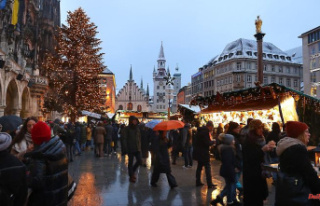The view through the living room window shows that the holidays are coming up. There is already a Christmas tree here and there in the living room. Many will only buy one in the next few days.
Schwerin/Marlow (dpa/mv) - A lot of wood is currently going through the net drum at the Christmas tree stands in the state. "Now the absolute high season begins," said Benedikt Schneebecke, head of the Christmas tree plantation Ostseetanne in Marlow (Vorpommern-Rügen district). It is true that he delivered trees to companies and municipalities and Christmas markets at the beginning of November. But now the private customers come and choose their trees for the living room.
Ostseetanne plants Christmas trees on 160 hectares. From three-year-old seedling to more than ten-year-old 2.5-meter trees, there are just over a million trees there. The tree starts shedding needles as soon as it gets indoors. "Water well," advises Schneebecke. "And, if possible, cut a slice off the tree trunk. The tree needs up to two liters of water a day."
The favorite among the Christmas trees is the Nordmann fir. Nationwide, they have a market share of around 85 percent for Christmas trees, said Saskia Blümel, Managing Director of the company Favoritentanne and the family business Blümels in Moisburg near Hamburg. There aren't really any big differences between East and West. "Traditionally, more blue spruce and pine trees are bought in the eastern federal states."
Anyone who decides on a Christmas tree has to dig more or less deep into their pockets, depending on the size. In general, prices throughout Germany have always fluctuated within the range of 21 to 27 euros per linear meter in recent years, but in most cases they have been on the lower limit, emphasized Blümel. According to industry estimates, the Germany-wide share of imports is less than ten percent of the total market. Most of them come from Denmark.
According to Christian Mai, board member of the Federal Association of Christmas Tree and Greenery Producers in Germany, it is still difficult to predict how December will develop. "But we are expecting a high demand for Christmas trees this year as well." In previous years, business was also dependent on the weather. As soon as it got really cold, customers became more aware of Christmas and tree sales rose accordingly, says Mai, who is also the managing director of the Werderaner Tannenhof and the Thüringer Tannenhof.
However, many forestry offices in MV also link the Christmas tree sale on the corresponding weekends with small Christmas markets, with the sale taking place in the respective forestry offices at different times. Putting up Christmas trees at Christmas time is a cultural asset that Landesforst MV maintains through its own cultivation and sale in the region.
It is also important to address the climate and environmental aspects. A spokeswoman recommended that the Christmas tree should come from a regional plantation. It is also important to note the ecological and social standards under which the trees were produced. "Our Christmas trees have suffered from the drought this summer, especially in the eastern parts of the country, but there have been no major losses nationwide."












